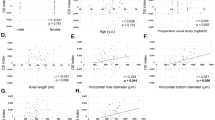Abstract
Background
The optical coherence tomography (OCT) and clinical characteristics of traumatic macular holes (TMHs) can be compared to those of idiopathic macular holes (IMHs) to gain insights into the pathogenesis of both.
Methods
The demographic data and visual acuity of 73 consecutive patients with unilateral, full-thickness TMHs and 182 consecutive patients with idiopathic IMHs were recorded. All patients with TMH and 60 patients with IMH underwent OCT scanning and quantitative measurements. The apical and basal diameters and marginal retinal thicknesses were recorded for each hole. The hole areas and eccentricities were calculated. These parameters were compared between the two types of macular holes, and correlated with visual acuity.
Results
Compared to IMHs, TMHs were generally thinner, larger at the base, less circular, and were associated with worse vision. Vitreous detachment was more commonly associated with IMHs than TMHs. Both IMHs and TMHs were wider horizontally than vertically. Visual acuity was negatively correlated with the size of IMHs, but not with any tomographic parameters in TMHs.
Conclusion
The tomographic and clinical findings associated with TMHs and IMHs provide useful insights into the pathogenesis of these two types of macular holes.

Similar content being viewed by others
References
Gass JD (1995) Reappraisal of biomicroscopic classification of stages of development of a macular hole. Am J Ophthalmol 119:752–759
Altaweel M, Ip M (2003) Macular hole: improved understanding of pathogenesis, staging, and management based on optical coherence tomography. Semin Ophthalmol 18:58–66
Kuhn F, Morris R, Mester V, Witherspoon CD (2001) Internal limiting membrane removal for traumatic macular holes. Ophthalmic Surg Lasers 32:308–315
Arevalo JF, Sanchez JG, Costa RA, Farah ME, Berrocal MH, Graue-Wiechers F, Lizana C, Robledo V, Lopera M (2008) Optical coherence tomography characteristics of full-thickness traumatic macular holes. Eye 22:1436–1441
Huang J, Liu X, Wu Z, Lin X, Li M, Dustin L, Sadda S (2009) Classification of full-thickness traumatic macular holes by optical coherence tomography. Retina 29:340–348
Chylack LT Jr, Leske MC, McCarthy D, Khu P, Kashiwagi T, Sperduto R (1989) Lens opacities classification system II (LOCS II). Arch Ophthalmol 107:991–997
Gass JD (1988) Idiopathic senile macular hole: its early stages and pathogenesis. Arch Ophthalmol 106:629–639
Gaudric A, Haouchine B, Massin P, Paques M, Blain P, Erginay A (1999) Macular hole formation: new data provided by optical coherence tomography. Arch Ophthalmol 117:744–751
Chauhan DS, Antcliff RJ, Rai PA, Williamson TH, Marshall J (2000) Papillofoveal traction in macular hole formation: the role of optical coherence tomography. Arch Ophthalmol 118:32–38
Kishi S, Takahashi H (2000) Three-dimensional observations of developing macular holes. Am J Ophthalmol 130:65–75
Ito Y, Terasaki H, Suzuki T, Kojima T, Mori M, Ishikawa K, Miyake Y (2003) Mapping posterior vitreous detachment by optical coherence tomography in eyes with idiopathic macular hole. Am J Ophthalmol 135:351–355
Yamashita T, Uemara A, Uchino E, Doi N, Ohba N (2002) Spontaneous closure of traumatic macular hole. Am J of Ophthalmol 133:230–235
Delori F, Pomerantzeff O, Cox MS (1969) Deformation of the globe under high-speed impact: its relation to contusion injuries. Invest Ophthalmol 8:290–301
Yanagiya N, Akiba J, Takahashi M, Shimizu A, Kakehashi A, Kado M, Hikichi T, Yoshida A (1996) Clinical characteristics of traumatic macular hole. Jpn J Ophthalmol 40:544–547
Johnson RN, McDonald LH, Grand MG, Murray TG, Mieler WF, Johnson MW, Boldt HC, Olsen KR, Tornambe PE, Folk JC (2001) Traumatic macular hole: observations, pathogenesis, and results of vitrectomy surgery. Ophthalmology 108:853–857
Hirata A, Tanihara H (2004) Ruptured internal limiting membrane associated with blunt trauma revealed by indocyanine green staining. Graefes Arch Clin Exp Ophthalmol 242:527–530
Tornambe PE (2003) Macular hole genesis: the hydration theory. Retina 23:421–424
Yamada H, Sakai A, Yamada E, Nishimura T, Matsumura M (2002) Spontaneous closure of traumatic macular hole. Am J Ophthalmol 134:340–347
Uchino E, Uemura A, Ohba N (2001) Initial stages of posterior vitreous detachment in healthy eyes of older persons evaluated by optical coherence tomography. Arch Ophthalmol 119:1475–1479
Liu X, Ling Y, Mei L, Zheng X, Hu Z, Liu S (1999) Characteristic and quantitative measurement of idiopathic macular hole with optical coherence tomography. Zhonghua Yan Di Bing Za Zhi 15:205–208 (In Chinese)
Chang LK, Koizumi H, Spaide RF (2008) Disruption of the photoreceptor inner segment-outer segment junction in eyes with macular holes. Retina 28:969–975
Author information
Authors and Affiliations
Corresponding author
Additional information
Supported by Grant 30901648 from National Natural Science Foundation of China.
Conflict of interest
Dr. Sadda is a co-inventor of Doheny intellectual property related to optical coherence tomography that has been licensed by Topcon Medical Systems, and is a consultant for Heidelberg Engineering. He also receives research support from Carl Zeiss Meditec and Optovue Inc.
Rights and permissions
About this article
Cite this article
Huang, J., Liu, X., Wu, Z. et al. Comparison of full-thickness traumatic macular holes and idiopathic macular holes by optical coherence tomography. Graefes Arch Clin Exp Ophthalmol 248, 1071–1075 (2010). https://doi.org/10.1007/s00417-009-1226-z
Received:
Revised:
Accepted:
Published:
Issue Date:
DOI: https://doi.org/10.1007/s00417-009-1226-z




